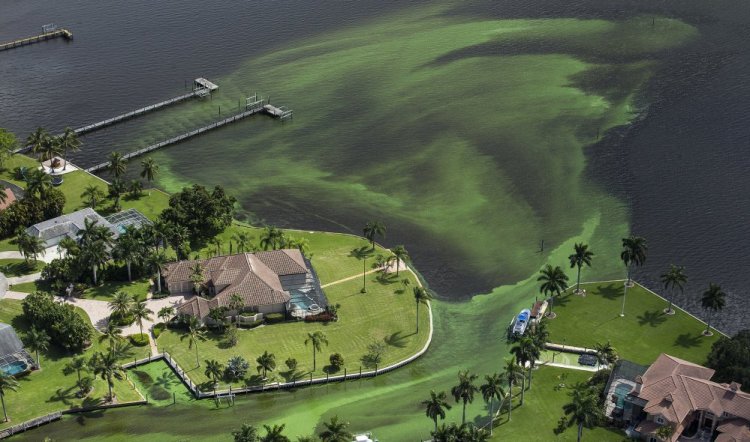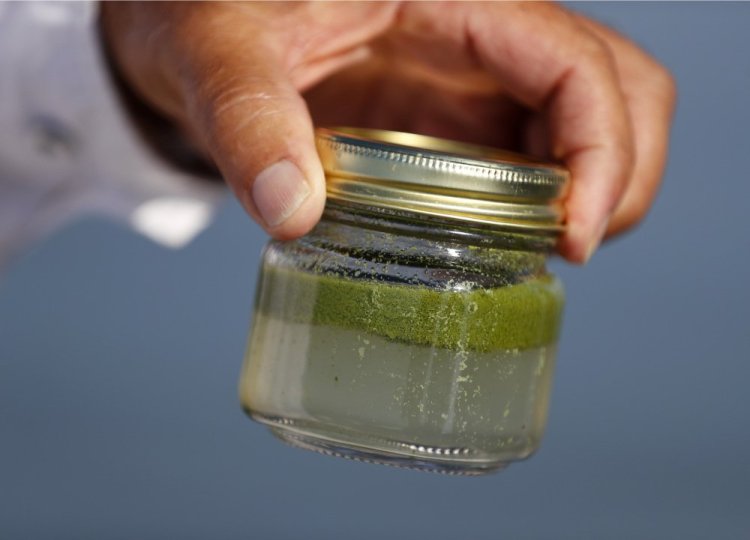MONROE, Mich. — Competing in a bass fishing tournament two years ago, Todd Steele cast his rod from his 21-foot motorboat – unaware that he was being poisoned.
A thick, green scum coated western Lake Erie. And Steele, a semipro angler, was sickened by it.
Driving home to Port Huron, Michigan, he felt lightheaded, nauseous. By the next morning he was too dizzy to stand, his overheated body covered with painful hives. Hospital tests blamed toxic algae, a rising threat to U.S. waters.
“It attacked my immune system and shut down my body’s ability to sweat,” Steele said. “If I wasn’t a healthy 51-year-old and had some type of medical condition, it could have killed me.”
He recovered, but Lake Erie hasn’t. Nor have other waterways choked with algae that’s sickening people, killing animals and hammering the economy. The scourge is escalating from occasional nuisance to severe, widespread hazard, overwhelming government efforts to curb a leading cause: fertilizer runoff from farms.
Pungent, sometimes toxic blobs are fouling waterways from the Great Lakes to Chesapeake Bay, from the Snake River in Idaho to New York’s Finger Lakes and reservoirs in California’s Central Valley.
Last year, Florida beaches were closed when algae blooms oozed from Lake Okeechobee. More than 100 people fell ill after swimming in Utah’s largest freshwater lake. Pets and livestock have died after drinking algae-laced water. Oxygen-starved “dead zones” caused by algae decay have increased thirty-fold since 1960, causing massive fish kills.
Algae are essential to food chains, but these tiny plants and bacteria sometimes multiply out of control. Within the past decade, outbreaks have been reported in every state, a trend likely to accelerate with global warming.
“It’s a big, pervasive threat that we as a society are not doing nearly enough to solve,” said Don Scavia, a University of Michigan environmental scientist.
Many monster blooms are triggered by an overload of agricultural fertilizers in warm, calm waters, scientists say.
Government agencies have spent billions of dollars on the problem. But an Associated Press investigation found little to show for their efforts:
• Levels of algae-feeding nutrients such as nitrogen and phosphorus are climbing in many lakes and streams.
• A small minority of farms participate in federal programs that promote practices to reduce fertilizer runoff. When more farmers want to sign up, there often isn’t enough money.
• Despite years of research, it’s debatable how well these measures work.
Instead of ordering agriculture to stem the flood of nutrients, regulators usually seek voluntary cooperation, an approach not afforded other big polluters. Farmers are asked to take steps such as planting “cover crops” to reduce off-season erosion – often with taxpayer subsidies.
The U.S. Natural Resources Conservation Service, part of the Department of Agriculture, says it has spent more than $29 billion on voluntary programs since 2009.
Jimmy Bramblett, deputy chief for programs, told AP that the efforts had produced “tremendous” results, but he acknowledged that only about 6 percent of the nation’s roughly 2 million farms are enrolled at any time.
In response to a Freedom of Information Act request, the agency provided data about its biggest spending initiative, the Environmental Quality Incentives Program, or EQIP, which contracts with farmers to use pollution-prevention measures and pays up to 75 percent of their costs.
An AP analysis shows the agency paid more than $1.8 billion from 2009 to 2016 to share costs for 45 practices targeting runoff.
A total of $2.5 billion was pledged during the period. Of that, $51 million was for farmers in the watershed flowing into western Lake Erie, where fisherman Steele was sickened. Yet the lake’s largest bloom on record appeared in 2015, blanketing 300 square miles – the size of New York City. The previous year, an algae toxin forced a two-day tap water shutdown for more than 400,000 customers in Toledo, Ohio.
Many experts say limiting runoff is the only way to rein in rampaging algae.
“We’ve had decades of approaching this issue largely through a voluntary framework,” said Jon Devine, senior attorney for the Natural Resources Defense Council. “Clearly the existing system isn’t working.”
The Environmental Protection Agency says indirect runoff from agriculture and other sources, such as urban lawns, is now the biggest source of U.S. water pollution. But a loophole in the Clean Water Act of 1972 prevents the government from regulating runoff like it does sewage and industrial waste.
Without economic consequences for runoff, farmers have an incentive to use all the fertilizer needed to produce the highest yield, said Mark Clark, a University of Florida ecologist. “There’s nothing that says, `For every excessive pound I put on, I’ll have to pay a fee.’ There’s no stick.”
Send questions/comments to the editors.




Success. Please wait for the page to reload. If the page does not reload within 5 seconds, please refresh the page.
Enter your email and password to access comments.
Hi, to comment on stories you must . This profile is in addition to your subscription and website login.
Already have a commenting profile? .
Invalid username/password.
Please check your email to confirm and complete your registration.
Only subscribers are eligible to post comments. Please subscribe or login first for digital access. Here’s why.
Use the form below to reset your password. When you've submitted your account email, we will send an email with a reset code.